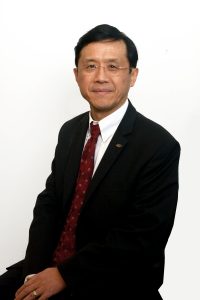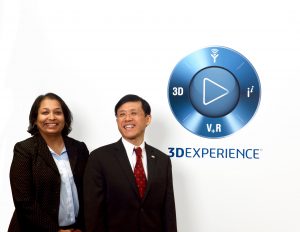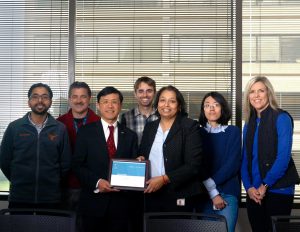
Recently, we had the opportunity to speak with simulation champion, Allan Zhong, a technology manager for innovation at Halliburton, about his election as a fellow of the American Society of Mechanical Engineers (ASME) in September 2018. Allan is a leading expert in applied mechanics and finite element methods with over 20 years of industry experience in both the tire industry and most recently, in the oil and gas industry. He earned his Ph.D. in applied mechanics from the California Institute of Technology, and his Master’s degree in computational solid mechanics from Tsinghua University in Beijing.
Being elected a Fellow of ASME is a distinct honor. It is awarded to engineers for their outstanding achievements and contributions in their field. Just three percent of the 110,000 ASME members are fellows! Allan’s impact was recognized for the following:
- Achievements in the tire industry – development of an industry leading fracture mechanics-based truck tire durability model
- Industry application of the finite element method to solve challenging engineering problems
- Pioneering the application of metallic 3D Printing at Halliburton and one of the early adopters of 3D Printing in the Oil and Gas Industry
- Service to the technical community
Allan also represents Halliburton as a leader in industry and university collaborations and serves on industry advisory boards for major universities in the Dallas-Fort Worth area, as well as being active in the Society of Petroleum Engineers. Learn more about Allan’s work in our interview with him below.
SIMULIA: What does it mean to be elected a Fellow of ASME?
It is a great recognition from my peers and ASME. This is a tremendous honor and I am very proud of this election.
SIMULIA: At what point in your life did you know you wanted to be become a mechanical engineer?
Allan: I was very interested in math in middle school because I did well in the subject without trying too hard. As I got older, I found pure math to be difficult and noticed that it had little direct impact on real life. Instead, I selected a field that uses a lot of math but has direct applications to real world problems, i.e. theoretical and applied mechanics, the foundation of mechanical engineering. I decided to become a mechanical engineer.
SIMULIA: How did you learn about Abaqus?
Allan: I discovered Abaqus as I worked on interfacial failure during my postdoctoral research in 1996.
What impressed me the most was the superior Abaqus documentation (user’s manual, example manual, etc.). Using these tools enabled me to master Abaqus and its advanced capabilities, allowing me to complete the research successfully and on time. I also published three papers along the way!
SIMULIA: When did you first begin using finite element analysis (FEA) to solve problems in the Oil and Gas Industry?
Allan: I started to use FEA in the oil and gas industry in 2003 when I left Goodyear Tire and Rubber Company and joined Halliburton as a technical advisor for mechanical engineering, where I provided FEA support to product development teams. The reason I joined Halliburton in the oil and gas industry was that, at the time, applications of FEA in oil/gas were limited. This meant that I could help form the strategies, which would advance applications of FEA, CFD and other engineering simulation tools and make an impact at Halliburton and in the industry as a whole.
SIMULIA: How has simulation evolved over the years?
Allan: I see significant advances in our core FEA code, especially Abaqus, in the robustness in contact modeling, significant advancement in fracture mechanics modeling, fatigue modeling and topology optimization.
We are moving the software and the applications from single physics modeling to multi-physics modeling, from single scale modeling to multi-scale modeling. This is a significant advance in the SIMULIA software and numerical technology. It helps to improve model fidelity.
Another advancement is that we can handle much larger FEA models in a shorter timeframe due to high performance computing, especially cluster computing, which was not imaginable 15 years ago.
Simulation life cycle management, such as the 3DEXPERIENCE platform, which integrates various numerical technologies on a single platform, and harvests and shares knowledge gain during the practice, is very important to the advancement of software technology.
When we combine the advancement of numerical technology with the change in mind-set of how to apply it, we will achieve the goal of using simulation to help develop reliable, optimally performing products, while reducing product development time and cost.
SIMULIA: How do you see simulation benefiting the oil and gas industry in the future?
Allan: The potential benefits of engineering simulation are recognized at the highest level of management in the oil and gas industry, and many companies have listed ‘engineering simulation and computational modeling’ as an enabling technology and a pillar in their technology portfolio.
Simulation will have broader applications in every segment in the industry from upstream to downstream sectors. It will also help to enable digitization of the oil field. The impact to product development and field operation will be tremendous, with reduction in physical tests.
SIMULIA: Can you tell us about your volunteer work and leadership position with the Chinese Institute of Engineers (CIE)/USA-DFW?
Allan: When my kids were young, I started volunteering as their soccer coach. I did not play soccer myself, but I learned with them and coached for three to four years. The team went from winning about 50% of their games at the beginning to becoming #2 in the district! I started volunteering for CIE/USA-DFW, a nonprofit organization, with its youth program MathComp/MathFun (MCMF) in 2014 to promote STEM in the Dallas – Fort Worth communities. We recruit local companies to come to our event and to bring math-based games for the kids to play as they wait for the results of the math competition. The goal of the event is to increase students’ interests in math through fun games.
After a year of volunteering, the organization asked me to serve as its Vice President for youth programming. My primary responsibility was to promote STEM in the community. During this time, I also started organizing MCMF and Robotics competitions. In 2017, I was elected EVP, and in 2018, President, assuming the responsibilities of running the organization. We organize two annual symposiums aimed at educating the community, including professionals, high school students and community members, about technology and engineering with local university professors and top engineers from major corporations based in the DFW area. Although my volunteer work is very demanding, it is greatly satisfying to see the impact we have made to the community.
In conclusion, I am very grateful to SIMULIA! They have powerful tools with a full portfolio of technology. The annual user conferences provide me with a platform to communicate with my peers and highlight my work. Thank you!

